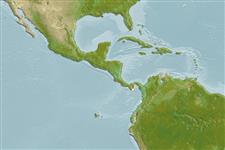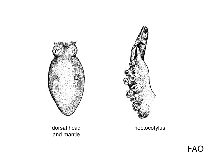Euaxoctopus panamensis Voss, 1971
Crescent octopus| Native range | All suitable habitat | Point map | Year 2050 |

|
| This map was computer-generated and has not yet been reviewed. |
| Euaxoctopus panamensis AquaMaps Data sources: GBIF OBIS |
رده بندی / Names اسامي عام | مترادف | CoL | ITIS | WoRMS
Cephalopoda | Octopoda | Octopodidae | Octopodinae
Environment: milieu / climate zone / تغييرات عمق / distribution range بوم شناسي
; تغييرات عمق 0 - 50 m (مرجع 83938). Tropical
Distribution كشورها | مناطق سازمان خوار و بار جهاني (FAO) | Ecosystems | ظهور | معرفي
Eastern Central Pacific: Colombia, Costa Rica and Panama.
Length at first maturity / Size / Weight / سن
بلوغ: Lm ? range ? - ? cm Max length : 20.0 cm TL جنس نر / بدون خواص جنسي; (مرجع 96968)
Life cycle and mating behavior بلوغ | تولید مثل | تخم ریزی | Eggs | Fecundity | Larvae
مآخذ اصلی
مراجع | هماهنگ كننده | همكاران
Hochberg, F.G. and Y.E. Camacho-García 2009 Squids and octopuses. p. 399-408 Wehrtmann, I.S.; Cortés, J. 2009. Marine biodiversity of Costa Rica, Central America. Springer 538pp. (مرجع 83938)
وضعيت در فهرست قرمز IUCN
(مرجع 130435: Version 2025-1)
وضعيت از نظر سايتس (مرجع 108899)
CMS (مرجع 116361)
خطر برای انسان ها
استفاده انسانی
| FishSource |
ابزارها
اطلاعات بيشتر
تركيب غذايي
مصرف غذايي
شکارچیان
Max. ages / sizes
Length-weight rel.
Length-length rel.
نوسانات طولی
Mass conversion
فراواني
منابع اينترنتي
BHL | BOLD Systems | CISTI | DiscoverLife | FAO(Publication : search) | Fishipedia | GenBank (ژنوم, نوکلئوتيد) | GloBI | Gomexsi | Google Books | Google Scholar | Google | PubMed | Tree of Life | Wikipedia (برو, جستجو) | Zoological Record



